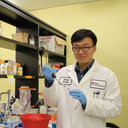Achyranthes bidentata root extract prevent OVX-induced osteoporosis in rats.
Λέξεις-κλειδιά
Αφηρημένη
OBJECTIVE
The objective of the present study was to systematically investigate the effects of Achyranthes bidentata root extract (ABRE) on postmenopausal osteoporosis.
METHODS
Eighty 3-month-old female Sprague-Dawley rats were used and randomly assigned into sham-operated group (SHAM) and five ovariectomy (OVX) subgroups, i.e. OVX with vehicle (OVX); OVX with 17 β-ethinylestradiol (E(2), 25 μg/kg/day); OVX with ABRE of graded doses (100, 300, or 500 mg/kg/day). Daily oral administration of ABRE or E(2) started on week 4 after OVX for 16 weeks. Bone mass, bone turnover and strength were analyzed by dual-energy X-ray absorptiometry (DEXA), biochemical markers and three-point bending test. The trabecular bone microarchitecture was evaluated by microcomputed tomography (μCT).
RESULTS
16 weeks treatment of ABRE slowed down the body weight gain and prevented the loss of bone mass induced by the OVX. The prevention effect on bone loss was due to altering the rate of bone remodeling, which could be inferred from the decreased level of bone turnover markers, such as serum alkaline phosphatase (ALP), osteocalcin (OC) and urinary deoxypyridinoline (DPD). The changes of urinary calcium and phosphorus excretion provided the same evidence. The treatment could also enhance the bone strength and prevent the deterioration of trabecular microarchitecture.
CONCLUSIONS
We conclude that 16 weeks of ABRE treatment improve bone biomechanical quality through modifications of bone mineral density (BMD), and trabecular microarchitecture without hyperplastic effect on uterus, and it might be a potential alternative medicine for treatment of postmenopausal osteoporosis.


